|
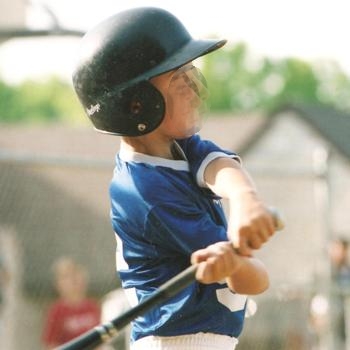 What
is Bat
Drag? What
is Bat
Drag?
Bat Drag is one of the most common and problematic
swing flaws and affects both baseball and fast pitch
softball hitters, usually starting in middle school, when pitchers
start throwing a bit harder.
Bat Drag is the main reason why good grade school
hitters stop hitting and start swinging through
everything and striking out.

Bat Drag
The key characteristic of Bat Drag is that the back elbow gets ahead of
the hips in the swing.

Bat Drag
Sometimes WELL ahad of the hips.

Bat Drag
The tricky thing about Bat Drag is that it can result in a swing that is VERY powerful, but
one that is too LONG to catch up to a good fastball. In the best case,
that means hits, and power, are always to the opposite field.
What is Bat Drag?
For a number of reasons, starting with my following the
conventional wisdom about hitting, both of my boys developed problems with Bat
Drag. That meant I had to quickly become an expert in the topic.
This piece, and my related piece on
Fixing Bat Drag, document my journey in trying to help my boys
and their friends.
While some label Bat Drag a
sequence problem,
it is more fundamentally a power
source problem; it is the result of the hitter
trying to power their swing...
...rather than...
- Middle-up with their CORE
...via the Rotation of their hips.
Bat Drag is caused by the hitter
trying to power their swing with their hands and arms — usually
their dominant, back arm — rather than their hips and core.
While that DOES work, and can create a POWERFUL swing, such a
swing is too LONG to catch up to a good fastball.
That's why hitters with Bat Drag often go from being the best
hitter on a team to the worst.
Often within a season or two.
Symptoms of Bat Drag include...
- Increasing numbers of swinging strikeouts.
- Pounding the ball into the ground between the plate and
the pitcher.
- Often LOTS of power but increasingly, and then only, to the
opposite field or foul.
- Hitting for average, with superior power, until 5th
grade or so, and then not hitting.
- An increasing, and eventually excessive, uppercut.
What's going on is that, as the hitter's back elbow leaks
forward due to Bat Drag, the barrel drops and gets stuck behind the
rear elbow.

Bat Drag
That causes the swing
to take too long to develop, and to
Whip too far out front, for the hitter to be able to catch up to a good fastball.

Bat Drag
What's tricky about Bat Drag is that the extra distance and time
it takes the swing to unfold WILL give the barrel more time to get
up to speed and WILL result in a higher Exit Velocity and more power.
Sometimes, a LOT of power.
At the cost of foul balls, often to the opposite field.
And strike-outs.
And, increasingly so.
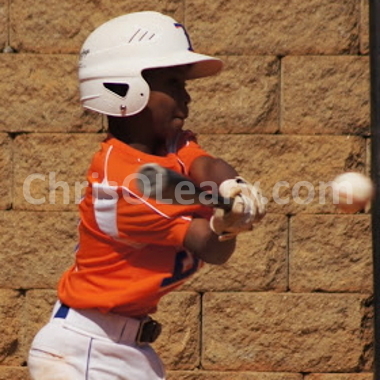
Bat Drag
While in rare cases — such as Mark Reynolds
and Mike Olt — hitters with Bat Drag don't stop hitting until they
reach a high level of the game, they will stop hitting.
At least for average.
Both of my boys had serious problems with Bat Drag — as a result
of my following some well-intentioned and common, but ultimately problematic,
advice — and my efforts to help them drove the research behind this piece.
I then turned it into a webbook called
Fixing Bat Drag that describes, in detail, what I did to help my boys
and their friends and classmates.
Fixing Bat Drag costs just $29 and is GUARANTEED to work.
If you don't solve the problem, you don't pay anything.
Fixing Bat Drag is also available, for FREE,
as part of my hitting & pitching bundles.
Chris,
After getting my daughter hitting lessons with no success
I finally decided to take it upon myself to correct her
bat drag.
After trying everything that I knew, I decided to pay the 29
bucks and get your information. I thought what do I have to
lose. After working with your program for only a couple of
weeks my daughter had a scrimmage game. She is a 10th grader
and plays outfield for the high school team. On her first at
bat she hit the ball very hard in
the gap for a double.
I want to thank you personally for helping me remedy the
bat drag. It is the best information
I have come across by far. I have attached a picture of her
swing which is remarkably better. Her hands are in front of
her elbow.
We have used the George Brett drill with great success. Her
power has doubled and is pulling the ball sometimes.
Thanks again for your help. We are gonna continue to work
to get her the best swing possible.
Bryan R.
February 2020
The most common characteristics of a problem with Bat Drag include...
Power That Doesn't Scale
One frequent tip-off that a hitter has a problem with Bat
Drag is that they start out their career with tons
of multi-field power in tee-ball, coach pitch, and/or machine
pitch. However, as they start to move up through the levels of
kid pitch — and especially around 5th or 6th grade, when
pitchers start throwing harder — their batting
average falls through the floor.
Only Pushing The Ball
Because Bat Drag affects when and where the barrel whips, and
lengthens the swing as a result, hitters with a problem with Bat
Drag will often develop a tendency to push the ball (e.g. hit the ball to the
opposite field).
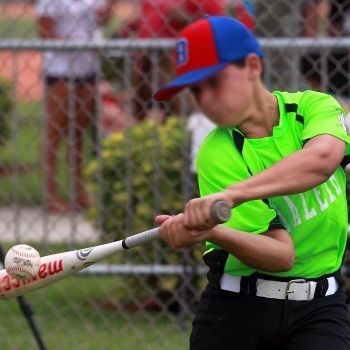
Bat Drag
This often won't cause an obvious immediate problem. In the
case of a right-handed batter, it may simply result in lots of
doubles and triples into the right field corner. However, in
most cases the hitter will reach the point where most of their balls
will land foul down the right field line (left field line in the
case of a left-handed batter) and their strikeouts will
skyrocket.
Pounding the Ball into the Ground Between the Plate and the Pitcher
In many cases, a problem with Bat Drag can cause the hitter
to pound balls — and especially balls up in the strike zone —
down into the ground between the plate and the pitcher.
Excessive Uppercut
While some uppercut is good, too much of an uppercut can
be just as problematic as chopping down on the ball.

Bat Drag
An excessive uppercut will tend to reduce the overlap of the pitch plane and the swing plane.
Lots Of Swinging Strikes
One symptom of a swing that is being affected by Bat Drag is
an increasing number of swinging strikes. The problem is that
Bat Drag is lengthening the swing and making the bat late
through the hitting zone.
Great Hitter During Batting Practice,
Poor Hitter In Games
Another indicator that a hitter may have a problem with Bat
Drag is that they absolutely kill the ball in batting practice, and in
particular when hitting off of a batting tee or during soft-toss
drills, but constantly strike out when going up against good, live
pitching. Bat Drag isn't an issue, and is
often an asset, when the ball is
either standing still or moving very slowly. Instead, Bat Drag
is only an issue when the pitcher is able to bring it with decent velocity.
Needing the Tee Well Forward
in the Stance
In retrospect, one indicator of my younger son's Bat Drag was
that he was literally unable to hit off of a batting tee if the
tee was placed closer than the toe of his front foot. He had to
push the tee forward, or back up, in order to be able to hit the
ball. Of course, that was because his back elbow was leaking
forward and was causing his swing to unfold farther out front than
was typical (or optimal).
In hitters with Bat Drag, on video you will see a back elbow that...
- Leaks, slides, or races forward of their back hip.
- Ends up under their front elbow.
...such that...
- Their elbows are close together.
- Their forearms are almost parallel.
- Forming a tight, horizontal V shape.
...as the barrel is about to release into the Point Of Contact.
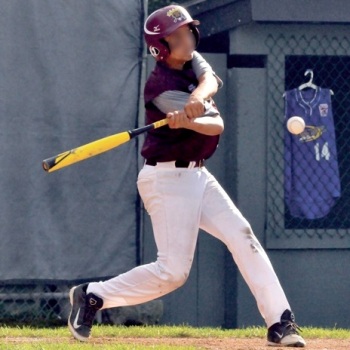
Bat Drag
Bat Drag causes problems by...
- Causing the barrel to drop and loop, creating an excessive uppercut
in the swing.
- Moving the point of contact forward, reducing the hitter's
adjustability and ability to hit off-speed pitching.
In the best case, that means power to the opposite field.
For a while.
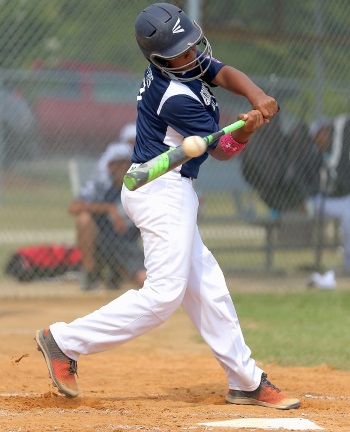
Bat Drag
However, due to the way Bat Drag causes the barrel to drag
behind, rather than whip around, the hands at the Point Of
Contact, it eventually means lots of foul balls to the opposite
field, balls pounded into the ground in front of the pitcher
and, eventually, lots of strikeouts.

Bat Drag
The reason you don't see (much)
Bat Drag in high school hitters isn't because it doesn't
happen to them. Rather, it's because most
hitters with Bat Drag simply can't hit high school pitching.
Or, too often, middle school pitching.
Based on the large number of young hitters I have seen or worked with,
I would estimate that upwards of 80 percent of young hitters have some
degree of Bat Drag in their swings.
What happens during Bat Drag is that, fairly early on in
the swing, the hitter's back elbow gets ahead of their top hand.

Bat Drag
As a result, at contact, the hitter will exhibit the telltale stacked
elbows, Sideways V position...

Bat Drag
...with the back elbow under the front
elbow and the forearms parallel, horizontal, and level to the ground
into and at contact.

Bat Drag
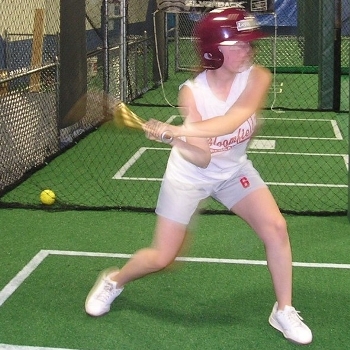
Bat Drag
In the worst cases of Bat Drag, the hitter's back
elbow will slide well forward of their top hand, causing the barrel to drop.
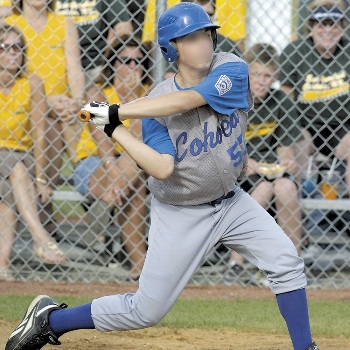
Bat Drag

Bat Drag
As a result, at the Point Of Contact the hitter's back elbow
will be well forward of their back hip, their back upper arm
will be more horizontal than vertical, and their swing will unfold
well out in front of them.
Bat Drag creates a swing that is sometimes very powerful but that is always
very long; typically too long to catch up to a good fastball or
to adjust between a fastball and a quality off-speed pitch.
Bat Drag changes where, when, and how
the bat head starts to whip. As in the case of
Mark Reynolds, that forces the hitter to make contact with the
ball farther out front than is optimal, which hurts their
ability to read the pitch and adjust to the ball.

Mark Reynolds

Mark Reynolds
In Mike Olt's case, his back elbow slid well forward of his
back hip, causing him to consistently hit the ball well out
front.

Mike Olt

Mike Olt
As players get older — usually older than 11 or
so — the result of a swing with Bat Drag is occasionally lots of
powerfully hit foul balls and/or hits to the opposite field, and sometimes doubles and home runs, but
typically lots of swinging strikes.
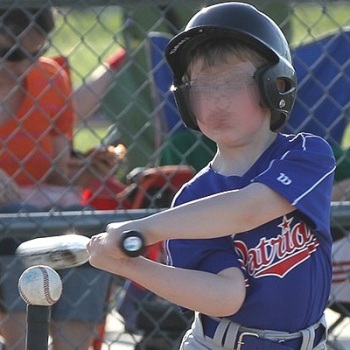
Grand Slam Home Run
I have seen Bat Drag turn 5th grade,
.500-average power hitters into 6th graders who
struggle to get one weak hit per game (or season).

Home Run
Many people use the terms Bat Drag
and Bat Lag interchangeably when, in truth, they are opposites.
As I explain in my piece on
Bat Drag vs. Bat
Lag, Bat Drag is the sign of a
serious, but common, problem with the swing while Bat Lag
is a normal and necessary component of a swing and the
sign of a powerful swing.
My Experience
A while back I was cleaning up my web site and stumbled
across the video below of my older son playing Home Run Derby in
our side yard in May 2006. This video was taken back before I
knew much about hitting. I hadn't had to put much thought or
time into his swing because he had hit quite well up until that
point, hitting for both power and average.
The thing that is really prominent in this video is significant Bat Drag,
which explains why he started to struggle that year.
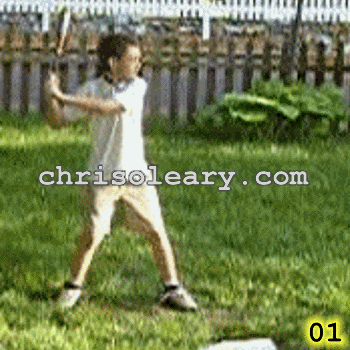
Bat Drag
Notice how, as he starts his swing, his front arm bars and
his back elbow slides
forward of his back hip. This lengthens his swing and moves the Point Of Contact forward.

Bat Drag
Frame 5

Bat Drag
Frame 6
In Frame 6, notice how his back elbow has slid well forward
of his back hip and is under, and is almost touching, his front elbow.

Bat Drag
Frame 7
The existence of Bat Drag in my older son's swing makes sense,
given his difficulties at the time.
Over the years, his batting average
declined as the pitchers got better and he started seeing more
than just glorified batting practice fastballs. He also became increasingly
likely to hit
the ball hard to right field or just foul down the right field
line, both of which are signs of a swing that is being slowed
down and lengthened by Bat Drag.
My younger son also had a problem with Bat
Drag. In the clip below, notice how his back elbow
slides forward. That makes the barrel dump and causes him to swing with too steep of an
uppercut.
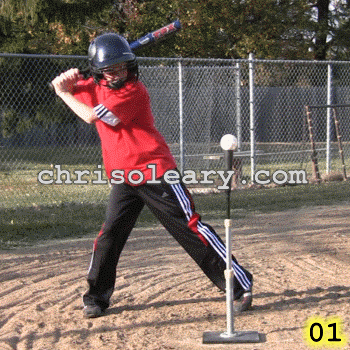
Bat Drag
That frequently caused him to top the ball and pound it into the
ground.
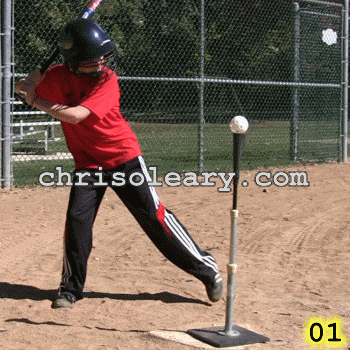
Bat Drag
His problem with Bat Drag also caused him to make contact farther forward than good
hitters do, which made him vulnerable to any pitch that wasn't
thrown at the speed he was used to.
What Doesn't Work
As I discuss at length in the public portion of my
Fixing Bat Drag eBook, when working with my older son on his Bat
Drag, I tried literally every (supposed) fix,
including all of the fixes for Bat Drag that are touted on YouTube
and that come up below this article. However, when I looked at the resulting swings on
120fps video, nothing had changed for the better.
What's more, in many cases, the "fix" made his problem with Bat
Drag worse.
As a result, I was forced me to develop my own approach to
fixing Bat Drag, and did so over the course of five years of work
with my younger son and his team.
Before and After
As a result of years of experience working with my sons and hundreds of young hitters in our
youth baseball and softball program, I have developed an
approach to fixing Bat Drag that is easy to implement and that
can quickly yield dramatic results.

Before
In the case of my younger son, we were able to transform his swing from the one above,
which was heavily affected by Bat
Drag and rarely led to solid contact, to the one below
that produces consistent, hard-hit line drive singles, doubles,
and home runs and has made him the 3-hole hitter on every team
he has played for since fourth grade.

2 Years Later

2 Years Later
I have distilled the lessons I have learned about fixing Bat
Drag of my sons and their friends into
Fixing Bat Drag, a webbook and eBook that explain why Bat Drag
happens, how to prevent it, and how to fix it.
Fixing Bat Drag costs just $29 and is GUARANTEED to work.
If you don't solve the problem, you don't pay anything.
Fixing Bat Drag is also available, for FREE,
as part of my hitting & pitching bundles.
To get to work on saving your hitter's swing and love
of the game, just click the Buy Now button.
Chris,
Just a follow up from the previous email.
My daughter started at CF for the JV team. After 20 at
bats, her hitting average is .400.
She has since been moved to the varsity team and plans to
start in LF tonight for the varsity.... totally amazing.
Your bat drag
program is a bargain for $29, it is worth much more. I
would encourage anyone struggling with bat
drag to get this information. By far
it is the BEST info on the web and it's not even close!
Thanks again,
Bryan R.
March 2020
|
































